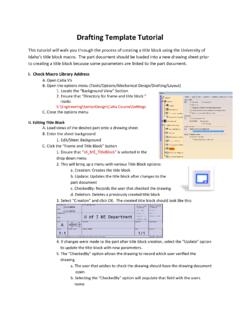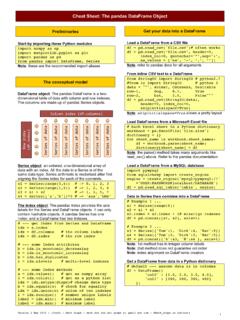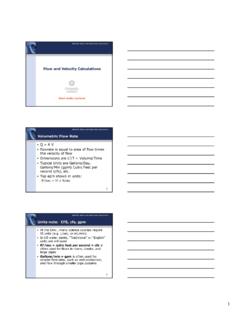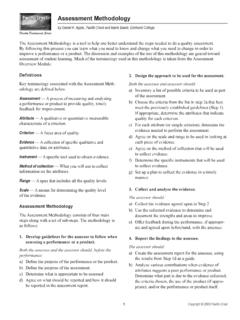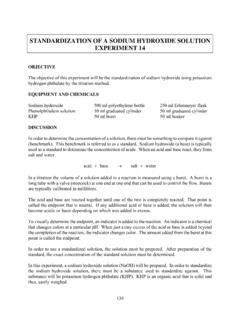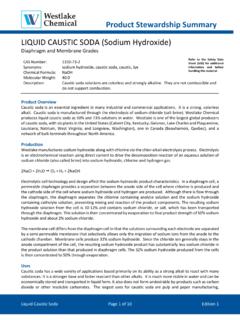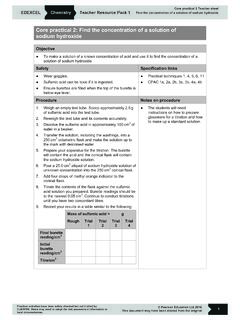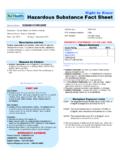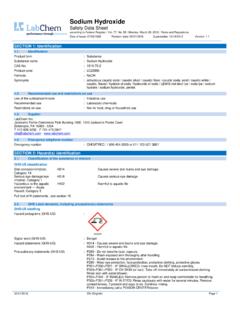Transcription of PREPARATION OF A STANDARD SODIUM HYDROXIDE …
1 Rev 2016-09-23 27 Experiment 3 PREPARATION OF A STANDARD SODIUM HYDROXIDE SOLUTION, DETERMINATION OF PURITY OF IMPURE KHP AND STANDARDIZATION OF HYDROCHLORIC ACID 2 lab periods Reading: Chapter 1 (pg 22-24), Chapter 8, and Chapter 11 (pg 206-212; 219-223; 225-226) of Quantitative Chemical Analysis, 8th Edition, Daniel C. Harris (7th Edition: Chapter 7 (pg 121-125), Chapter 9, and Chapter 11 (pg 200-206 and 212-218). CHEM 253 Quantitative Analysis Laboratory Experiments, 7th Edition, pg 6-11. Objective This lab will introduce you to the concept of the analytical titration. You will learn how to standardize strong acids and bases and how to determine the purity of an impure weak acid. The lab will allow you to practice the basic laboratory skills you need in order to perform accurate and precise titrations. Suggested Schedule Lab 1 Dry KHP and unknown at 105-110 C for at least two hours.)
2 Prepare NaOH and HCl solutions . Standardize. If there is time, do your calculations before leaving the lab. Lab 2 Titrate your impure KHP sample. Do your calculations before leaving the lab. In this experiment, you will prepare STANDARD solutions of SODIUM HYDROXIDE (NaOH) and hydrochloric acid (HCl). A STANDARD solution has a concentration that is exactly known. The STANDARD NaOH solution will be used to determine the purity of an impure solid acid and the STANDARD HCl solution will be used for analyses later on in the semester. Solid NaOH is very hygroscopic and contains many impurities. It is also difficult to measure out concentrated HCl with any accuracy. We don t know the exact composition of the solid NaOH or the exact concentration of the HCl solution. Thus, it is necessary to use another approach to determine the concentrations of the STANDARD solutions .
3 We will use the primary STANDARD acid, potassium hydrogen phthalate (KHP, a solid), to make an acid solution of known concentration. KHP can be weighed out very accurately on the analytical balance, and is available with a purity of KHP contains one titratable acidic functional group. We can titrate this KHP solution with our NaOH solution to standardize (determine the concentration of) the NaOH solution. Then, with our standardized NaOH solution, we can both determine the purity of an impure sample of KHP and titrate the HCl solution to accurately determine the HCl concentration. COO-COOHCOO-COO-K++ NaOHK+Na++ H2O Reaction 1: Titration of KHP with NaOH Rev 2016-09-23 28 Water which is in contact with the atmosphere can absorb carbon dioxide. In addition, SODIUM HYDROXIDE pellets adsorb carbon dioxide from the atmosphere.
4 Dissolved carbon dioxide acts as a weak acid in aqueous solutions , as shown in the following reactions. CO2(g) + H2O = H+ + HCO3 HCO3 = H+ + CO32 If basic solutions are prepared using water which contains dissolved carbon dioxide, a portion of the base reacts with the carbon dioxide to yield hydrogen carbonate (HCO3 ) or carbonate (CO32 ). For this reason, the STANDARD SODIUM HYDROXIDE solution is prepared using water from which all carbon dioxide has been removed. As mentioned above, STANDARD NaOH solutions cannot be prepared by weighing solid NaOH, since the reagent often contains significant amounts of impurities and is highly hygroscopic. STANDARD NaOH solutions are usually prepared by diluting a 50 wt% aqueous solution of NaOH to approximately the desired concentration. This solution is then standardized by titration of an acidic primary STANDARD .
5 In 50 wt% solutions of SODIUM HYDROXIDE , dissolved carbon dioxide precipitates as a carbonate. Prelaboratory Assignment 1) Calculate the volume of a concentrated solution of HCl required to prepare a 1 L HCl solution of approximately M. Concentrated HCl is ~ M. Hint: think about significant figures. 2) Calculate the volume of 50 wt% solution of NaOH required to prepare 1 L of M NaOH solution. The density of a 50 wt% NaOH solution is g/mL. Hint: there is a similar problem on pg 18 of your text. 3) A sample of pure KHP ( ) was dissolved in about 25 mL of distilled water, and titrated to the phenolphthalein end point with mL of a SODIUM HYDROXIDE solution. Calculate the molar concentration of the SODIUM HYDROXIDE solution. 4) A student obtains the following concentrations for her SODIUM HYDROXIDE solution from three individual titrations: M, M, M.
6 Calculate the average, STANDARD deviation, and %RSD for these results. Apparatus Large (1500 or 2000 mL) Erlenmeyer flask 3 250-mL Erlenmeyer flasks 50-mL buret 10-mL graduated cylinder 100-mL graduated cylinder 25-mL pipet Two 1-L polyethylene bottles or glass bottles with screw caps Two weighing bottles for drying the pure and impure KHP Rev 2016-09-23 29 Chemicals Hydrochloric acid (concentrated, ~12 M) (will be provided in a dispenser) Phenolphthalein solution ( wt% in ethanol) Potassium hydrogen phthalate ( ) Impure potassium hydrogen phthalate unknown-- record your unknown number in your lab notebook! 50 wt% NaOH solution (will be provided in a dispenser) Procedure A. Preparing a Stock Solution of M HCl If the M HCl solution is not provided you may prepare it as follows: Fill a 1 L bottle to its shoulder with distilled or deionized (DI) water. Use the dispenser in the hood to add the appropriate volume of concentrated HCl to the 1-liter bottle (you calculated this volume for the prelaboratory assignment).
7 Tighten the lid on the bottle, and thoroughly mix the solution by shaking the bottle. The hydrochloric acid now has a concentration near M. Clearly label and set this solution aside for future use. B. Preparing and Standardizing a Solution of NaOH 1. Dry about 3 g each of pure and impure potassium hydrogen phthalate in an oven set to l05-110 C for ~two hours. Use your weighing bottle, without lid, to hold the solid. Label a 150-mL beaker, put the weighing bottle in the beaker and cover with a watch glass. Always use this method to dry solids. After the KHP has dried in the oven for at least two hours, place it in a desiccator to cool to room temperature. This usually requires about 15 minutes. Weighing a warm solid will introduce substantial errors into your measurement, so be sure the solid is at room temperature. Note: to label the beaker, simply use a pencil to write on the white portion of the beaker.
8 Ink and tape will likely bake off in the oven. 2. Place at least L of DI water using available glassware, put these on the hot plate and bring to a boil. Allow to cool to room temperature. 3. Prepare a M solution of NaOH. To do this, fill a 1 L bottle to its shoulder with boiled and cooled DI water. Add the appropriate volume of 50 wt% NaOH solution to the 1 L bottle (you calculated this for the prelaboratory assignment). Tighten the lid on the bottle, and thoroughly mix the solution by shaking the bottle. 4. Weigh three to samples of the dry, pure KHP to the nearest mg ( g). Place each sample in a labeled, 250-mL Erlenmeyer flask. Add about 30 mL of boiled and cooled DI water to each flask, and dissolve the KHP. Rev 2016-09-23 30 5. In a fourth flask, add only 30 mL of boiled and cooled DI water. This will be your blank for a blank titration.
9 The blank titration is used to estimate the titration error. The blank titration tells the analyst how much titrant is needed to create an observable color change in a solution with no analyte. You will subtract the volume of titrant (NaOH solution) required for the blank from the volume of titrant required for the titration of the analyte (KHP). Get into the habit of doing blank titrations. 6. Add two or three drops of phenolphthalein solution to each flask, fill the 50-mL buret with NaOH solution, and titrate the KHP solution in each flask to the end point. You will see a pink color form in the flask. Towards the end of the titration, the color will start to persist in the solution. At the end point the solution changes from colorless to a very faint pink color. This color change will be permanent. The blank should require very little of the NaOH solution.
10 If the color at the endpoint is a deep pink or a dark magenta you have overrun the endpoint and need to repeat the titration. Each time you do the titration, make sure to titrate to the same point. The colors of your titrated solutions should match. (Lining your titrated solutions up on a white piece of paper makes them easier to compare). Important! Check your results! From the results of each titration, calculate the molarity of your NaOH solution. Calculate the average molarity, the STANDARD deviation and the %RSD for your measurements. A good analyst can obtain a %RSD of better than 1%. Repeat any measurements, if necessary. You may wish to use the Grubbs test or the Q test to determine if one data point may be discarded. You should have three good replicate analyses. C. Determining the purity of a sample of impure KHP 1. Repeat steps 1 through 5 for the impure KHP samples, this time weighing out between and g for each measurement.

